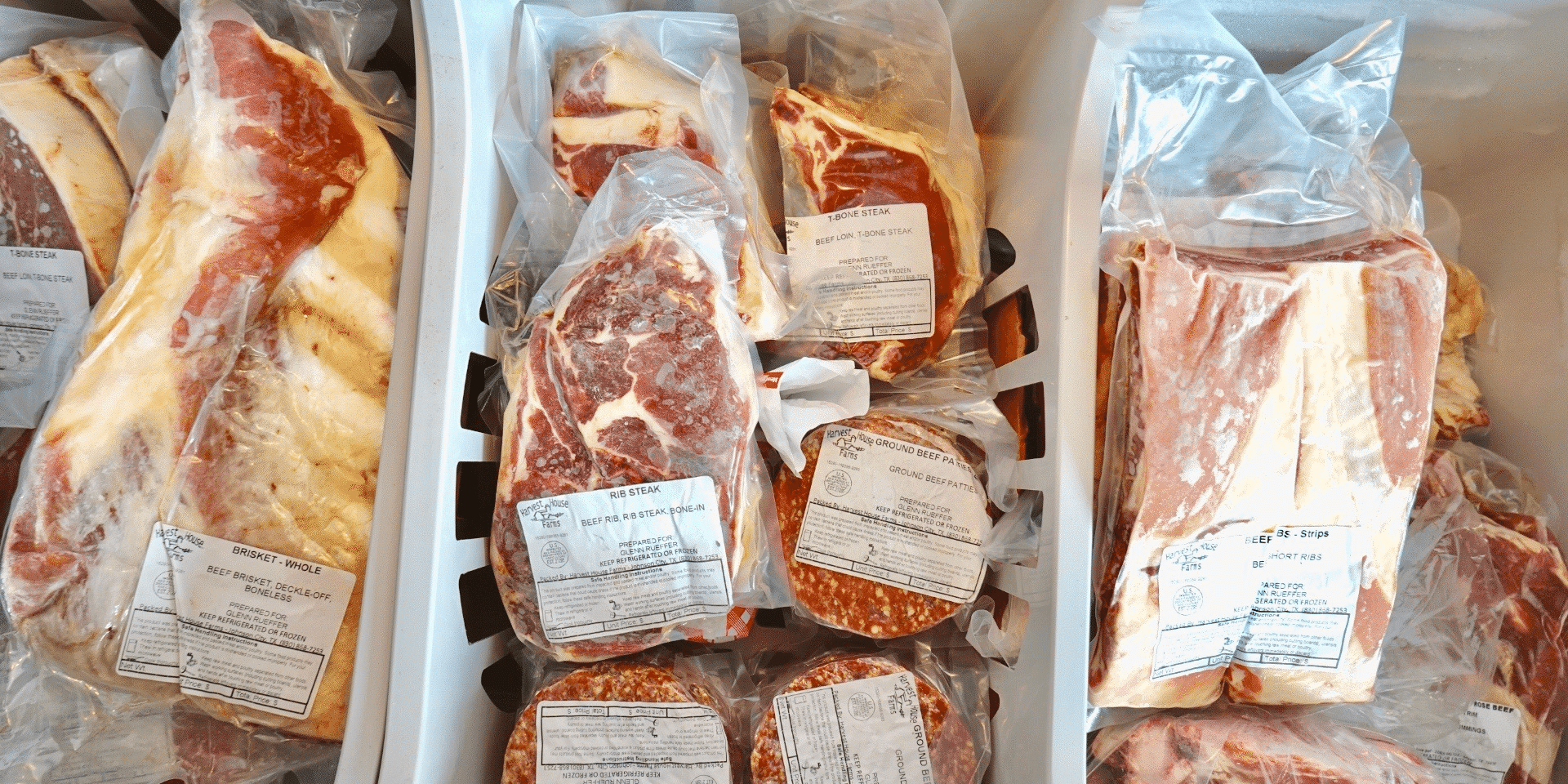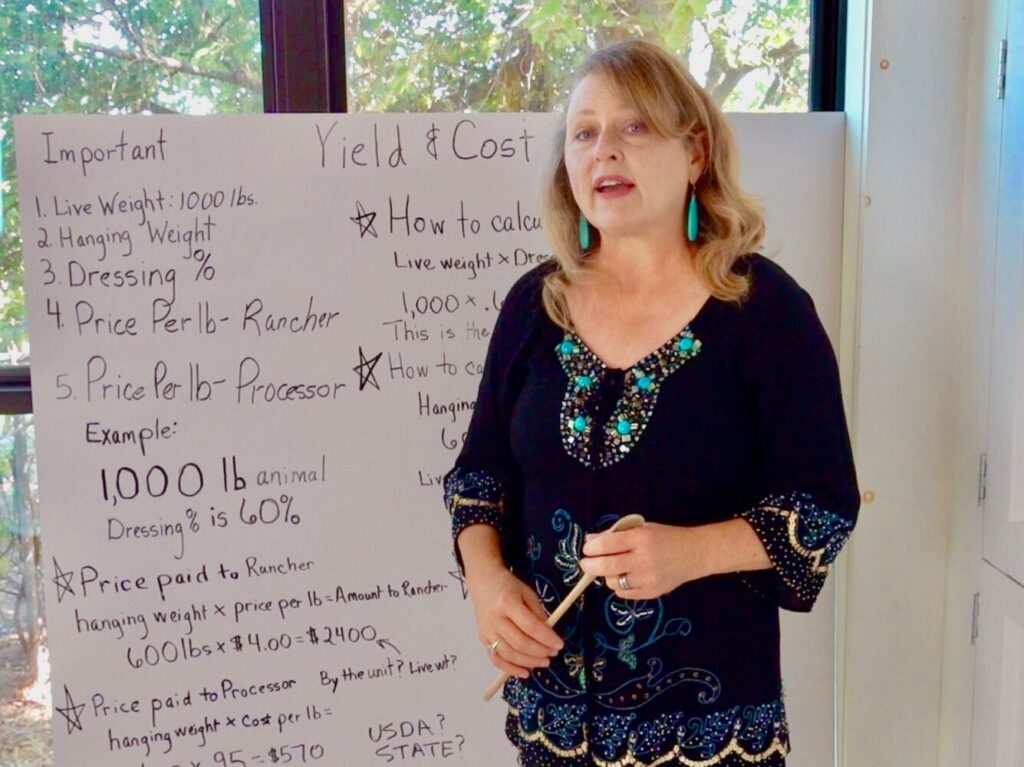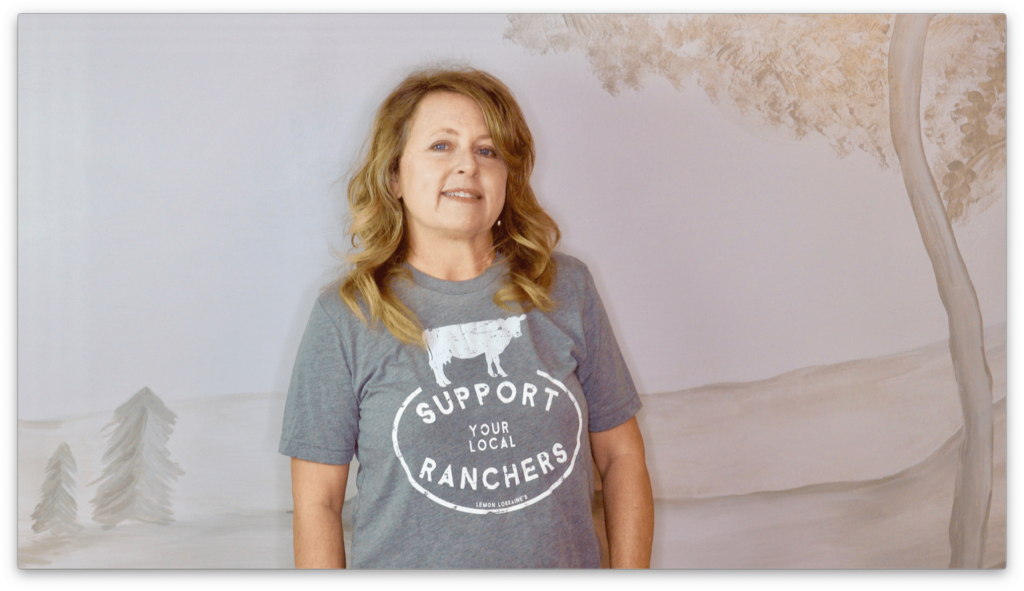NOW THAT YOU HAVE SOME RESOURCES FOR WHERE YOU CAN FIND BEEF, IT IS TIME TO LEARN HOW TO PROJECT BEEF YIELD AND COST. THIS INFORMATION IS VALUABLE IN THE DECISION-MAKING PROCESS. KNOWING THIS INFORMATION IS THE BEST METHOD FOR ESTIMATING, HOWEVER THE NUMBERS WILL ONLY BE ACCURATE AFTER THE ANIMAL IS HARVESTED.
When buying beef from a rancher, you need to know approximately the amount of packaged beef you will be taking home. This can be difficult because since the animal hasn’t been harvested, this is only a guess. The true numbers are only available after the animal is harvested. This is a paradigm but so worth learning! Today we are going to learn how to project an estimated amount of yield and the cost of the packaged beef you will be taking home.
First, you need a general understanding of these definitions, because they are the variables in the calculation to determine beef yield and cost.
- Live Weight – The weight of the animal when it leaves the ranch and before it is harvested. Our example: 1,000 lb animal
- Hanging Weight – The carcass weight after the animal is harvested and everything has been removed. Hanging weight is a percentage of live weight and that percentage (often called dressing percentage) can vary depending on a number of factors such as the breed of cattle and the age of the animal. Remember you won’t know the exact percentage until after harvest; That is why we are using an average dressing percentage.
- Dressing Percentage – The percent of live weight that gives you hanging weight. Today we are using the average dressing percentage 60%.
- The cost per pound of hanging weight paid to the rancher. Our example is $4.00 per pound of hanging weight.
- The processing charges per pound of hanging weight paid to the processor. Our example is $0.95 per pound of hanging weight.
Are there other ways to buy beef than by the pound per hanging weight?
Yes, and make sure you are very clear when you order beef. Some ranchers charge by the live weight and some ranchers charge a flat fee per head. Please watch our YouTube video, this will help you understand!
How to find estimated hanging weight?
Live weight X dressing percentage = hanging weight
1,000 X 60% = hanging weight
1,000 x .60 = 600 pounds (hanging weight)
600 pounds of estimated hanging weight from a 1,000 lb. animal.
Do all animals have the same dressing %?
NO, there are many factors that impact dressing %. Here are a few: The breed of cattle and the age of the animal. Even within the same breed each animal is unique and will be different. Dairy breeds often have a lower dressing percentage than beef breeds. Younger animals have a lower dressing percent also. The range is usually at the low end 50% and the high end 65%. You will not know until after the harvest!
A LOWER DRESSING PERCENT MEANS A SMALLER HANGING WEIGHT! JUST SAYS FOR EXAMPLE THAT THIS 1,000 LB. ANIMAL HAS A DRESSING PERCENT OF 50% INSTEAD OF 60%. THE HANGING WEIGHT WOULD BE 500 LB INSTEAD OF 600 LB.
Now let’s find how many pounds of packaged beef you will take home.
Remember this is an average and there is great variation.
Today we are going to using 75% as our average for shrinkage after dry aging and butchering the carcass.
Hanging weight x 75% = will give you the estimated pounds of packaged beef you will take home.
600 x .75 = 450 pounds of packaged beef to take home.
450 pounds of packaged beef to take home
Can you tell why the yield of beef can vary so much?
Yes, the 75% is an average but it can vary significantly. Just think about this, if you dry age the carcass it will shrink and lose moisture therefore, weigh less. If cuts are boned-in they will weigh more than boneless cuts. When the butcher removes the bones from the cuts there will be additional loss to trim. If you ask for all of the fat trimmed from the cuts this will lesson the yield. Just always remember this is a ballpark number and will vary from situation to situation.
How to calculate the price you will pay to the rancher.
PLEASE REFER BACK TO THIS POST TO FIND A LOCAL RANCHER: HERE
Hanging weight X Cost per pound of hanging weight = Price paid to the rancher
600 pounds x $4.00 = $2,400
$2,400 amount paid to rancher
The processing fee for butchering and packaging your beef can vary greatly but we will use the known price of $0.95 per pound of hanging weight for now. In Part 3 of this series I will show you a cut sheet and some of the charges for custom packaging.
I am using Texas processors in our examples but check with your local processor for a more accurate calculation.
The processor will charge a harvest fee $85 and $0.95 per pound of hanging weight. This is the first charge and depending on how your want your beef cut, additional products such as hamburger patties, tenderizing, and length of time of aging will impact price. Please make sure you ask to see a price and cut sheet from the processor.
$85 + $570 = $655 is the price paid to the processor
In Part 3 I will point out more details on the cut sheet and pricing.
*If you buy a half, the processor will charge each half a split fee. If you buy a quarter, then all four customers will each pay a fee.
Processing fees can add up fast so make sure you keep this in mind when filling out your cut sheet.
TOTAL COST OF BEEF
TOTAL COST OF BEEF PAID TO THE RANCHER + TOTAL COST PAID TO BUTCHER FOR PROCESSING = TOTAL COST OF BEEF
$2,400 + $655 = $3,055
THE ESTIMATED COST OF BEEF PER POUND CAN BE FOUND USING THIS CALCULATION
TOTAL COST OF BEEF PAID TO THE RANCHER + TOTAL COST PAID TO BUTCHER FOR PROCESSING = TOTAL COST OF BEEF
TOTAL COST OF BEEF ÷ BY TOTAL NUMBER OF POUNDS OF PACKAGED BEEF = TOTAL COST PER POUND OF BEEF
$3,055 ÷ 450 = $6.79 per lb. of beef
BEEF YIELD AND COST CAN VARY GREATLY, BUT REMEMBER ONLY FACTORY FARMED PRODUCTS ARE UNIFORM AND YOUR BEEF IS A HANDCRAFTED FOOD.
Let me suggest calculating several examples such as using a 50% hanging weight and another 60% and a 65%, this will give you a range of what to expect. This paradigm is new for most of us but will become familiar with time. As discussed in Part 1 of this series, it is very important to know and trust your personal rancher.
Best,
Caren
Make sure to bookmark this post so you can refer to it often!
To every thing there is a season, and a time to every purpose under the heaven: Ecclesiastes 3:1









